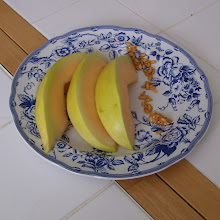Listening to Hilary Hahn play the Allemande to the D-minor partita, I'm hearing the way her violin rings more than I ever did before. In an earlier post, I talked about listening for the ringing of my own violin as I played the Allemande. This ringing is amazing. It's like her notes were bell chimes. The ringing of one note does linger in the air as she plays the next. The ringing of the bass notes is like the bass part that Bach didn't include in the "Six Solos For Violin without Bass Accompaniment," as he originally titled them. Sometimes, when I tune into the ringing, I imagine another note that isn't in the music that seems to follow in the bass line.
Arnold Steinhardt, a concert violinist and chamber musician, says he has been pursuing the elusive Ciaccona his whole life. I can imagine why. There's always more to hear in Bach.
Saturday, March 27, 2010
Friday, March 26, 2010
Open Source Interview about Bach's Ciaccona with Arnold Steinhardt
This is a radio program about the wonderful Ciaccona/Chaconne.
Thursday, March 25, 2010
Allemande
I can't find my Bach music, so I can't check to see how my edition spells Allemande. I can, however, play the movement I'm working on, because it's committed to my memory.
I've been imagining how the movement would sound on an organ. There are many rising arpeggios where I can imagine the notes building onto each other and the volume rising the way they would if an organist held each note down instead of releasing it to play the next note, the way you have to on a violin.
I'm also trying to listen for the way the ringing of one note mixes with the sound of the next. For example, if I play a note on one string, then play a note on another string, the first string continues to vibrate from that first note while I play the second. What does that sound like? The vibrations aren't as loud as those of an organ, but they exist. Whether I leave my fingers in place on the first string or take them off probably makes some minuscule difference.
The beginning of the Allemande is similar to the beginning of Ciaccona, the D-minor partita's epic movement. I wonder if Bach wrote the Allemanda first, or started with the Ciaccona. The Ciaccona is so important. It could be based on all of the previous movements, but because it's so fantastic, I suspect that Bach had it in mind from the beginning. Bach probably planned the Ciaccona before he started writing the Allemande, the way J.K. Rowling planned the end of the Harry Potter series before she finished the first Harry Potter book.
I like this recording, after the Star Wars introduction. This sounds like not just any violin. Maybe a Baroque violin.
I've been imagining how the movement would sound on an organ. There are many rising arpeggios where I can imagine the notes building onto each other and the volume rising the way they would if an organist held each note down instead of releasing it to play the next note, the way you have to on a violin.
I'm also trying to listen for the way the ringing of one note mixes with the sound of the next. For example, if I play a note on one string, then play a note on another string, the first string continues to vibrate from that first note while I play the second. What does that sound like? The vibrations aren't as loud as those of an organ, but they exist. Whether I leave my fingers in place on the first string or take them off probably makes some minuscule difference.
The beginning of the Allemande is similar to the beginning of Ciaccona, the D-minor partita's epic movement. I wonder if Bach wrote the Allemanda first, or started with the Ciaccona. The Ciaccona is so important. It could be based on all of the previous movements, but because it's so fantastic, I suspect that Bach had it in mind from the beginning. Bach probably planned the Ciaccona before he started writing the Allemande, the way J.K. Rowling planned the end of the Harry Potter series before she finished the first Harry Potter book.
I like this recording, after the Star Wars introduction. This sounds like not just any violin. Maybe a Baroque violin.
Sunday, March 21, 2010
Week of 3/21/10
B-flat major scale
Kreutzer 20
D-minor Partita, Allemanda
I think I'm on Kreutzer 20. I sporadically practiced for a while there, and I ended up on Kreutzer 20. Also, I played the last movement of the A-minor Sonata, too.
Kreutzer 20
D-minor Partita, Allemanda
I think I'm on Kreutzer 20. I sporadically practiced for a while there, and I ended up on Kreutzer 20. Also, I played the last movement of the A-minor Sonata, too.
Subscribe to:
Comments (Atom)
